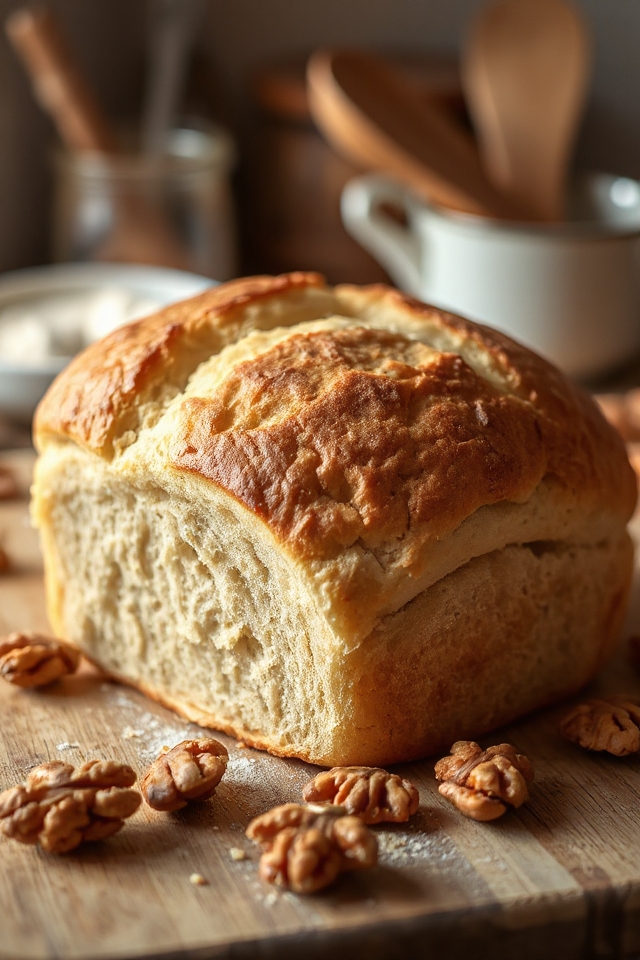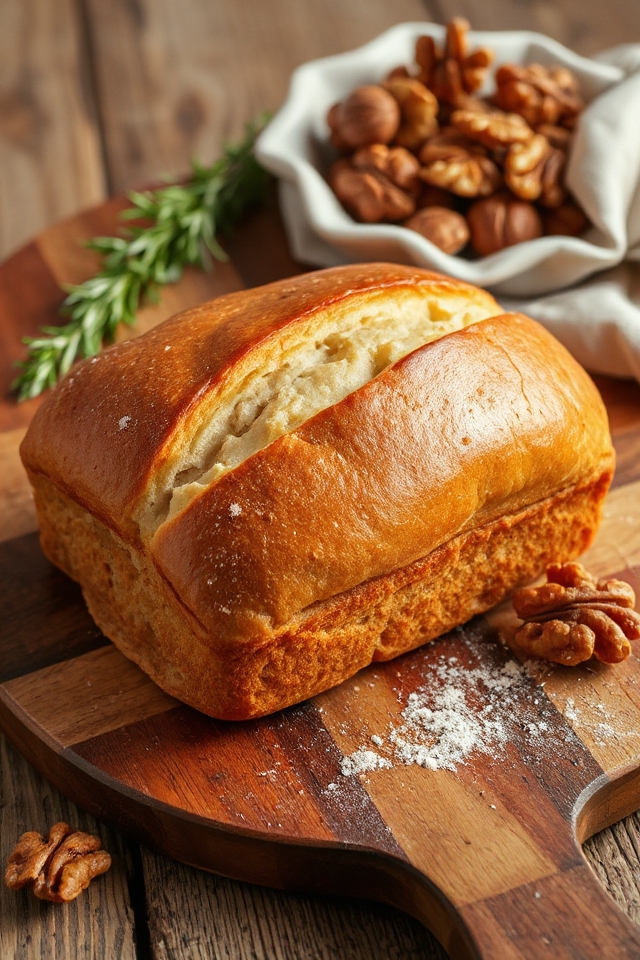Why You’ll Love This Walnut Bread Recipe
You’ll absolutely love this Walnut Bread recipe for its perfect blend of textures and flavors.
The crust turns golden and crispy, while the inside remains soft and airy. Each bite reveals the delightful crunch of toasted walnut halves, adding a rich, nutty dimension that elevates the bread.
I can’t get enough of how it fills my kitchen with a warm, inviting aroma as it bakes. Plus, it’s versatile—great for sandwiches or simply slathered with butter.
Once you try this recipe, you’ll find it hard to resist making it again and again. Trust me, it’s a must-try!
Ingredients of Walnut Bread
Making walnut bread is an adventure in the kitchen that’s as rewarding as it’s delicious. The ingredients come together to create a loaf that’s not only hearty and satisfying but also bursting with flavor. Imagine the aroma wafting through your home as the bread bakes—it’s like getting a warm hug from the oven.
So, let’s gather our ingredients and get ready to set off on this tasty journey!
Here’s what you’ll need to whip up your very own walnut bread:
- 1 egg
- 1/2 teaspoon salt (plus an additional 1 teaspoon for the dough)
- 1 cup warm water
- 1/4 cup light brown sugar
- 1 envelope dry yeast
- 3 cups bread flour
- 1/2 cup whole wheat flour
- 3 tablespoons walnut oil
- 1 1/2 cups walnut halves (that’s about a 6 oz. package)
Now, let’s take a moment to chat about these ingredients. The combination of bread flour and whole wheat flour gives our loaf a fantastic texture—think chewy yet soft, with just the right amount of crunch from those walnut halves.
And let’s not forget about the walnut oil; it adds a lovely nuttiness that really ties everything together. If you’re feeling adventurous, you could even toast the walnut halves before adding them to the dough for a deeper flavor.
Also, make sure your water is warm but not too hot; we want to wake up the yeast, not scald it.
How to Make Walnut Bread

Making walnut bread is like starting on a delightful adventure in your kitchen. Let’s dive right into it, shall we? First, take 1 cup of warm water and combine it with 1/4 cup of light brown sugar and 1 envelope of dry yeast in a measuring cup. Give it a little stir and then let it sit for about 10 minutes until it gets all foamy. This is the yeast waking up and getting ready to work its magic—like a morning cup of coffee for your dough.
While you’re waiting, you can grease or oil a large bowl and set it aside; we want our dough to have a cozy place to rise.
Now, grab your food processor and toss in 2 1/2 cups of bread flour, 1/2 cup of whole wheat flour, 3 tablespoons of walnut oil, and 1 teaspoon of salt. With the machine running, pour in that foamy yeast mixture and blend it all together until the dough starts to clean the sides of the bowl—this should take about 40 seconds.
If your dough feels too sticky, don’t panic; just add in that reserved 1/2 cup of flour a tablespoon at a time until it’s smooth and elastic. After that, push the dough down onto the blade and gently fold in 1 1/2 cups of walnut halves. Remember, we want to keep those nuts chunky, so don’t overprocess.
Once combined, transfer the dough to that oiled bowl, shape it into a ball, and cover it with a damp towel or plastic wrap. Now, the hardest part—waiting for it to rise until it doubles in size, which usually takes about an hour.
Once your dough has risen, it’s time to punch it down—literally! This is your chance to release all that built-up air. Turn it out onto a floured surface, shape it into another smooth ball, and cover it again. Let it rise for about 40 minutes while you preheat your oven to 400 degrees F.
When the dough has puffed up, slash the top a couple of times (this isn’t just for show; it helps the bread rise nicely while baking), and brush it with that egg and salt glaze you made at the start.
Now, pop it in the oven for 35 to 45 minutes until it turns golden brown and sounds hollow when thumped. And there you have it—a warm, nutty loaf of walnut bread that’s perfect for toasting or just enjoying on its own. Just try not to eat the whole thing in one sitting—trust me, it’s tempting.
Walnut Bread Substitutions & Variations
While walnut bread is delicious as is, there are plenty of substitutions and variations you can try to tailor it to your taste.
For a nuttier flavor, swap in pecans or hazelnuts for the walnuts. If you want a sweeter touch, consider adding honey instead of brown sugar.
You can also experiment with different flours; try spelt or rye for a unique texture. For a savory twist, mix in herbs like rosemary or thyme.
If you’re avoiding gluten, use a gluten-free flour blend. These tweaks can elevate your walnut bread and make it truly your own!
Additional Tips & Notes
Experimenting with substitutions and variations can really enhance your walnut bread experience. For a twist, try adding dried fruits like cranberries or apricots for a hint of sweetness.
If you’re looking for a nuttier flavor, consider using different nuts, such as pecans or hazelnuts. I love to sprinkle some seeds on top before baking for added texture.
When it comes to storage, wrap your bread in a cloth to keep it fresh longer.
And don’t forget—this bread makes fantastic toast! Just pop it in the toaster, and you’ve got a delicious breakfast or snack ready in minutes.
Enjoy your baking!
